Physics II Class 03/12
The figure below depicts a laser beam
passing through a jar of honey. The direction of the marker to the left of
the jar indicates the direction of the incoming beam.
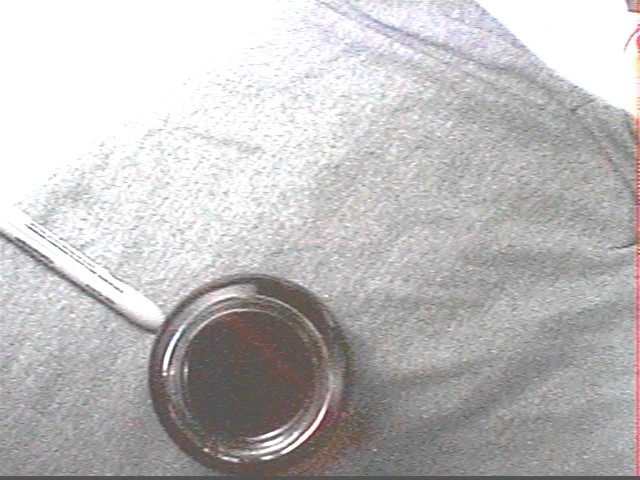
In the figure below the red line passing
through the center of the jar is parallel to the direction of the incoming
beam. We can see how the actual laser beam is refracted toward this beam.
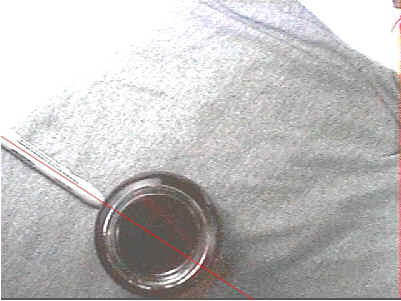
The figure below shows the actual beam
passing through the center of the jar.
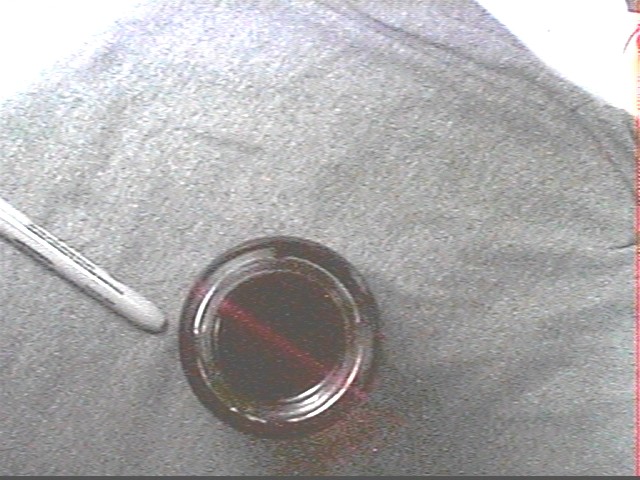
The next figure shows the red 'direction line' superimposed on
the preceding figure, to show that the direction line is indeed parallel to the
central beam.
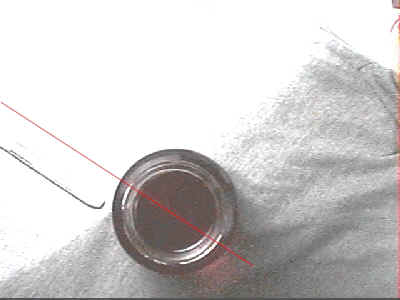
The figure below shows a beam which is fairly close to the
central beam
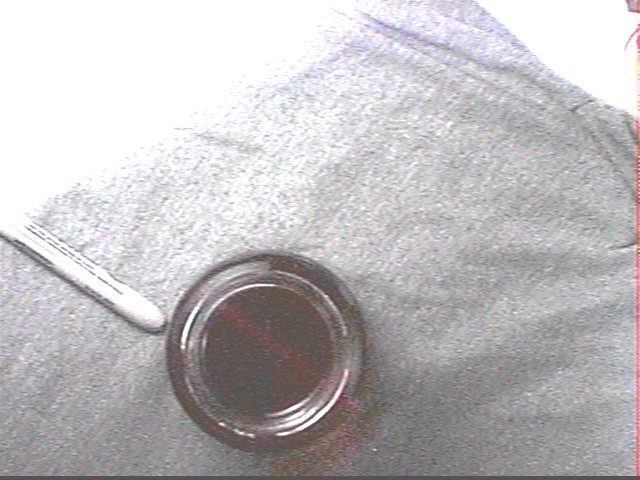
The next figure is identical to the preceding but with the red
line indicating the central beam superimposed.
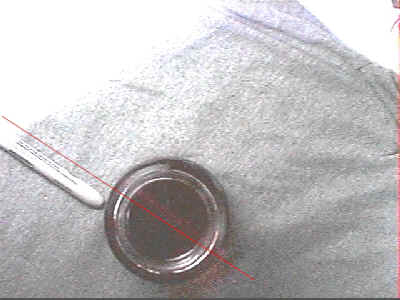
Refraction is first understood in terms of light beams passing
from air to water and from water to air, with a smooth horizontal water surface.
- The beam directed from air to water is indicated by the
arrows along the beam, indicating that the beam passes from air above to
water below.
- The angles theta(i) and theta(r) are measured with respect
to the line normal (i.e., perpendicular) to the water-air interface.
theta(i) is called the angle of incidence and theta(r) the angle of
refraction.
- For the beam which originates at the fish, near the left
side of the figure, the beam passes from air to water so the angle of
incidence is measured with respect to the normal line as the beam approaches
the water surface from within the water, and the angle of refraction is
measured as the beam moves into the air.
The index of refraction of a substance tells us how fast light
moves in that substance.
- The speed of light in a vacuum is c = 3.00 * 10^8 m/s,
accurate to 3 significant figures. A more accurate figure is c = 2.998
* 10^8 m/s.
- In a substance with index of refraction n, light travels at
speed c / n.
If light travels from a substance with lower index of
refraction into a substance with higher index of refraction, the direction of
the beam is changed, with the beam deflected toward the normal.
If light travels from a substance with higher index of
refraction into a substance with lower index of refraction, the direction of the
beam is changed, with the beam deflected away from the normal.
- The index of refraction of air is nearly 1, while the index
of refraction of water is significantly higher than 1.
- Therefore light beams passing from air to water are deflected
toward normal and those passing from water to air are deflected away from
normal.
The general rule is that for a beam passing the interface
between two substances with indices of refraction n1 and n2, the corresponding
angles theta1 and theta2 are related to the indices by
- Snell's Law: sin(theta2) / sin(theta1) = n1 / n2.
Note how the relationship is inverse, with sin(theta2) in the
numerator of one fraction and the index n2 of the corresponding substance in the
denominator of the other fraction.
- This law tells us that if n2 > n1, then sin(theta2) must
be less than sin(theta1).
- Since all angles are between 0 and 90 degrees, a domain on
which the sine function is increasing from 0 to 1, it follows that theta2
must be less than theta1.
- Thus if the beam passes between air (lower index) and water
(higher index) the angle in water will be less than the angle in air, as is
the case in both instances (air into water and water into air) below.
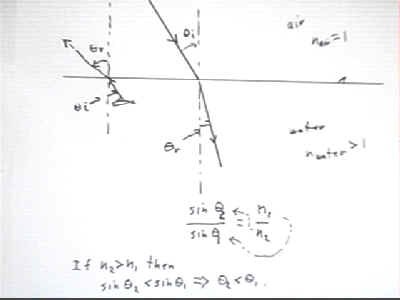
The figure below depicts beams passing from water to air at
progressively changing angles of incidence.
- The first beam is vertical, incident at a right angle.
- The next beam makes a significant angle with the surface
and is deflected away from the surface at an even greater angle.
- The third beam, incident at a greater angle than the
second, is deflected in a direction which is almost parallel to the water.
- The fourth beam, drawn in red, is deflected to a refracted
angle of 90 degrees, making it parallel to the water surface. The
incident angle at which this happens is called the critical angle.
- The fifth beam, incident at an angle even greater than the
critical angle, would be deflected at an angle greater than 90 degrees if it
was able to enter the air. However this is not the case, since at such
an angle the beam could not enter the air. Such a beam will be
completely reflected back into the water, with no loss of energy at the
point of reflection (the water itself absorbs some of the beam's energy as
the beam passes through the water, but there is no change in energy
associated with the reflection itself).
- As with any reflection the beam will be reflected at the
same angle to normal as the incident beam.
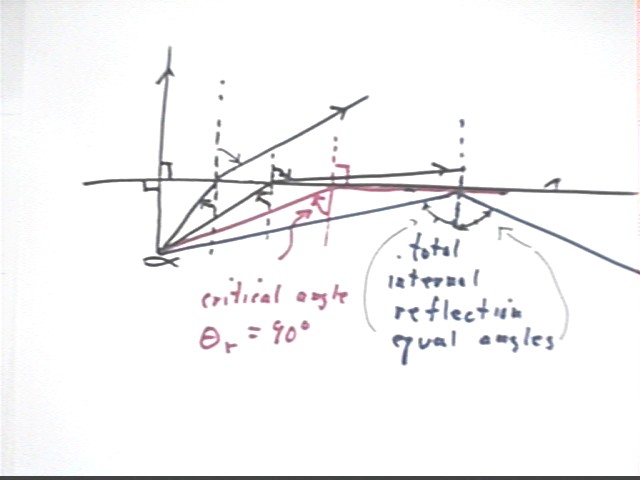
The figure below depicts the situation with light from a
distant point source passing through a cylinder filled with a substance whose
index of refraction exceeds that of the air. The beams depicted here are
analogous to the laser beams observed passing through the honey jar.
Since the source is assumed to be distant we can think of the
light as consisting of a large number of narrow beams, which because of the
distance of the source are parallel.
We consider a central beam and a beam which is parallel to the
central beam but which passes through the cylinder somewhat below the central
beam.
- As the second beam first encounters the cylinder at point
A, it interacts only with a very limited part of the cylinder's surface,
which in the neighborhood of a thin beam is therefore practially flat. The
direction of this flat surface is tangent to the cylinder, so that the
normal direction is that of a radial line from the center of the circle to
the point at which the beam meets the cylinder.
- The tangent and normal (radial) lines and the angles
theta(i) and theta(r) of incidence and refraction at this point are
indicated. We see that the beam is deflected toward the normal line,
which bends it slightly toward the central axis of the cylinder.
For a cylinder filled with water, honey, or most types of
glass the beam will not cross the central beam before reaching the opposite side
of the cylinder. For some substances (e.g., diamond) the beam will cross
the central beam.
Note also that the central beam encounters the cylinder at the
normal direction and that its angles of incidence and refraction are therefore
zero, so that it passes undeflected through the cylinder.
When the initially 'parallel' beam reaches the opposite end of
the cylinder it again encounters a locally flat surface which appears to be
parallel to the tangent line at that point. The angles theta(i) and
theta(r) of incidence and refraction are indicated at this point (point B).
- Since the beam passes from a higher to a lower index of
refraction its angle of refraction will be greater than its angle of
incidence, and it will be deflected away from the normal. This results
in a deflection 'toward' the central angle.
- It turns out that for all parallel beams reasonably close
to the central beam, the beam emerging from the cylinder will cross the
central beam at the same point. Beams which enter the cylinder further
from the center will miss this point, missing by more and more as the
distance from the central beam increases.
- It would be possible to shape a sort of elliptical or
parabolic cylinder in such a way that distant beams meet much closer to the
center.
We observed light from a candle approximately 2.5 meters away
as it was focused by two cylinders, one containing water and the other
honey. From our observations we are able to determine the indices of
refraction of these substances. We note a few sources of small but
significant error:
- 2.5 meters is not all that distant, so the beams that were
focused are not exactly parallel.
- It's hard to determine visually exactly at what position
the best focus occurs. If we could measure the intensity of the
focused light as a function of distance behind the cylinder, perhaps by
exposing photographic plates or using a tiny light sensor, we might obtain
more accurate results.
- Light travels not only through the substance filling the
cylinder by through the substance of which the cylinder is made. This
substance in fact was different for the two substances observed (plastic in
one case, glass in the other) and furthermore was of different thickness
(the glass was thicker than the plastic).
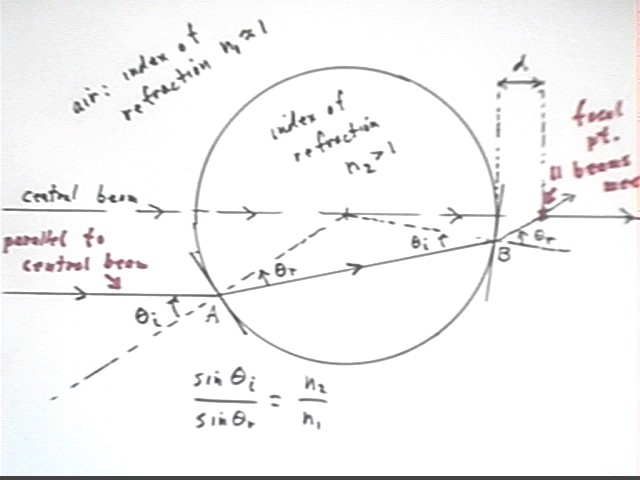
Using trigonometry and the geometry of the circle, we
determine that the distance d at which light focuses behind the cylinder is
related to the radius R of the cylinder and the index of refraction n of the
substance in the cylinder by the equation
The analysis is accessible at the precalculus level but is
reasonably involved.
Data obtained indicate that
- For a water-filled cylinder of outer diameter 6.99 cm
distance light focused at a point 6.5 cm from the central axis of the
cylinder.
- For a honey-filled cylinder of outer diameter 6.79 cm
distanct light focused at a point 5.0 cm from the central axis of the
cylinder.
It was assigned as a homework problem to find the index of
refraction of the water and the honey.
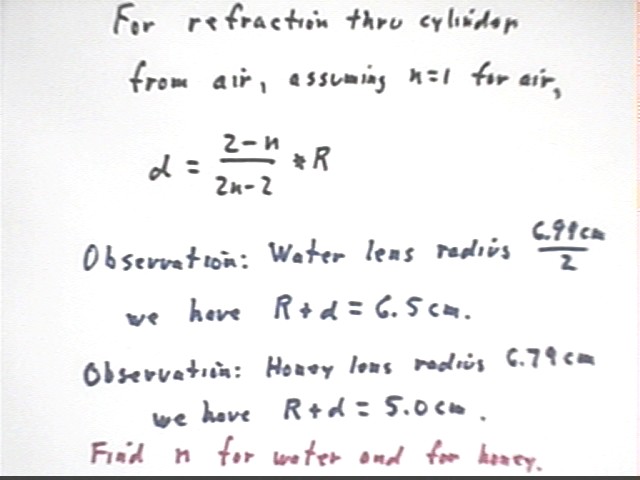
Note that for high index of refraction the focal point,
indicated here by the position at which a beam initially parallel to the central
beam intersects the central beam, will lie within the cylinder.
Note that for parallel beams further from the central beam the
severe change in direction results in the beams not meeting at the focal
point. However for beams near the central axis the focal point will be
valid.
- What is the maximum index of refraction that results in a
focal point outside the cylinder?
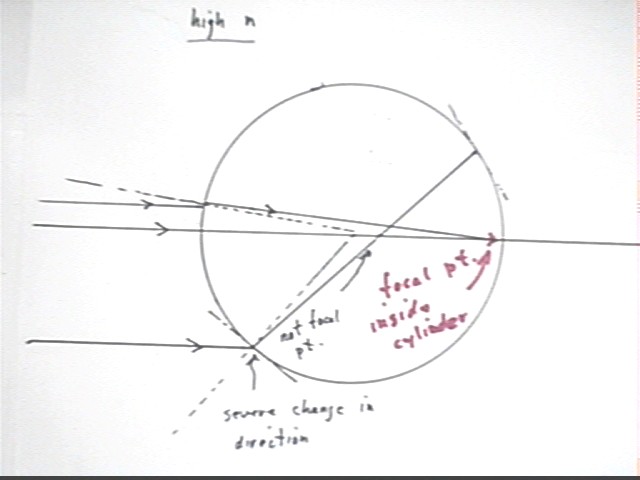
Assignment 14:
`gChapter 12 Problems 42, 46,
48, 52, 53 //
`uUniversity Physics:
Ch. 21 Problems 23, 24, 26, 27, 30
Assignment 15:
`gCh. 23 Problems 4, 11, 14, 17, 20//
`uUniversity Physics: Ch. 34,
Problems 25, 28, 35, 40, 42//
Assignment 16:
`gCh. 23 Problems 23, 34, 37, 43, 52//
`uUniversity Physics: Ch. 35,
Problems 45, 52, 59, 62, 68, 75//
`gCh. 23 Problems 58, 61; Ch. 24 Problems
4, 7, 10 Submit Ch. 24 #10//
`uUniversity Physics: Ch. 37,
Problems 37, 40, 46, 49, 54 Submit Ch. 37 #44//
Assignment 18:
`gCh. 24 Problems 15, 23, 28, 31,
34 //
`uUniversity Physics: Ch. 38,
Problems 40, 45, 46, 49, 51//
Assignment 19:
`gCh. 24 Problems 40, 43, 46, 51, 57,
60 Submit Ch. 24 #43//
Assignment 25:
`gText Chapter 16, Problems 8, 11, 14, 18
`uUniversity Physics: Chapter 22
Problems 52, 54, 57, 60, 63, 66, 67, 74, 79, 83, 84
Assignment 26:
`gText Chapter 16, Problems 26, 29, 32, 35
`uUniversity Physics: Chapter 23
Problems 20, 21, 25, 27, 33, 34, 40, 41
Assignment 27:
`gText Chapter 17, Problems 9, 12, 16, 19,
22
`uUniversity Physics: Chapter 24
Problems 49, 50, 55, 57, 58, 61, 65, 72, 75
Assignment 28:
`gText Chapter 17, Problems 34, 37, 39, 45,
48
`uUniversity Physics: Chapter 25
Problems 36, 37, 42, 45, 46, 49, 52
Assignment 29:
`gText Chapter 18, Problems 6, 7, 9, 12,
29, 36
`uUniversity Physics: Chapter 26
Problems 44, 47, 50, 55, 60, 61
Assignment 30:
`gText Chapter 20, Problems 11, 13, 17, 21,
32 Submit #32//
`uUniversity Physics: Chapter 28 Problems 41, 42, 46, 52,
57, 65, 66; Chapter 29 Problems 43, 46, 51, 56
Assignment 31:
`gText Chapter 21, Problems 10, 12, 15,
22
`uUniversity Physics: Chapter 30
Problems 31, 36, 41, 46











